The Calming Map of a Mandala…
This spring, we launched a new table mat and coaster collection inspired by the beauty of the mandala, a symbol of calmness and unity that seems so particularly relevant during these changing times. In this month’s Journal entry, we explore some of the mandala’s history and how artists and creators have been inspired by this design.
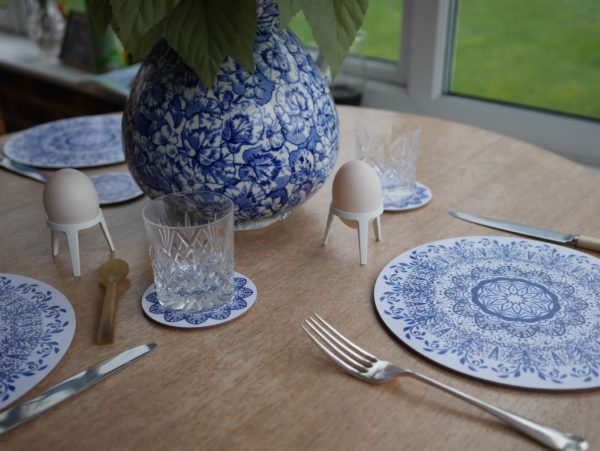
Blue & White Mandala Placemat & Coasters
Traditionally, a mandala is a symbol that contains a square within a circle, or vice versa, and follows a geometric design. The square is often arranged into sections, or a ‘quarternity’, meaning a multiple of four. Despite following a relatively simple format with these two key shapes, mandala designs can be wonderfully intricate and complex.

Mandala of Amitayus, 19th century Tibetan school, paint on wood. Rubin Museum of Art, New York. Image from wikimedia website.
The word ‘mandala’ is Sanskrit for circle, with some variations of the word meaning ‘magic circle’, and they can be found in many forms. Mandalas exist as paintings on a wall, as sand paintings on the floor, drawings on paper or on a scroll. They hold a great deal of spiritual significance, particularly in Buddhist and Hindu cultures where the mandala represents the universe, life’s eternity and our connection one to each other, and within ourselves.
Mandala designs and uses can be very different depending on the country and tradition they belong to and are often used as an aid during spiritual practices, such as meditation. It is believed that by focusing on the central point of a mandala, you will feel calmer and more centred over time. Indeed, their often symmetrical patterns can bring a sense of harmony and serenity within the viewer, and many mindfulness books are dedicated to simply drawing and colouring in mandala designs for their calming effect.

Bird’s eye view of Borobudur temple, a 9th century Buddhist temple in Central Java, Indonesia. Image from Pinterest.
The architectural layout of many Hindu and Buddhist temples follow the structure of a mandala; if you look at a bird’s eye view of these temples, you can see this more clearly. Lying at the centre of these temples is often a sculpture of a deity or god, such as the Buddha. Likewise, in depictions of mandalas in other forms, a deity may be depicted at the centre. In this way, mandalas act as a kind of map, guiding visitors, or viewers, to the most holy, central part.

“This is the first mandala I constructed in the year 1916, wholly unconscious of what it meant.” Carl Jung. Systema Munditotius (The System of All Worlds), Carl Jung, 1916. Pigment on paper. Image from gnosis website.
The famous Swiss psychoanalyst Carl Jung discovered the spiritual power of mandalas and the symbolism that they carried. He is often credited with introducing mandalas and their significance to the western world. Every morning, Jung would draw mandalas from his imagination into his ‘Red Book’ journal, one of many journals he had. He discovered that they were a fundamental way to understand more about his own psyche and unconscious mind. Later, he encouraged his patients to draw them too, seeing the mandala as a tool for understanding emotional states, as an opportunity to gain a sense of self-unity and completeness.

Page 105 from Carl Jung’s ‘Red Book’ Journal (1914-1930). Pigments on paper. Image from noornalini on tumblr.
“I sketched every morning in a notebook a small circular drawing, a mandala, which seemed to correspond to my inner situation at the time… Only gradually did I discover what the mandala really is: … the Self, the wholeness of the personality, which if all goes well, is harmonious.” C.G. Jung
Another way mandalas have been created is in sand. This ancient Tibetan Buddhist tradition involves forming complex designs with coloured sand. It is believed that sand mandalas as a form of spiritual art was introduced by the Buddha himself.
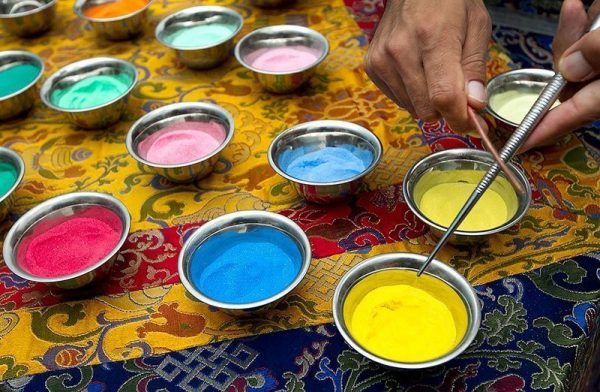
Coloured sand used for mandala creation. Image source Collective Vision
Monks skilfully worked on the sand mandala collaboratively, creating it on the floor. They are trained in the art form for several years before they are able to work on them. First, the design is meticulously marked out with chalk, a compass is often used to determine accuracy. Then, always working from the centre outwards, the monks use metal funnels, or ‘chak-pur’, to place the dyed sand to form the pattern. An elaborate process, it can take several weeks to complete the mandala, depending on its size.
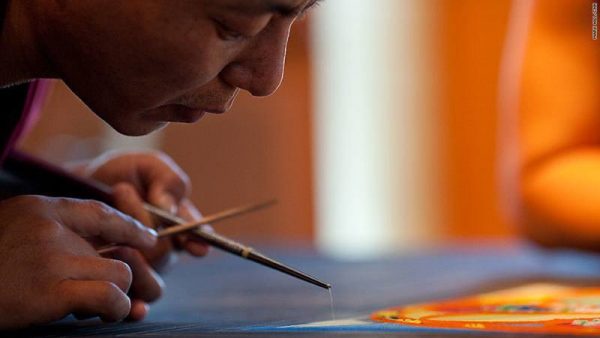
Millions of sand particles are carefully poured onto the outline using the chak-pur (seen above). The monk holds it in one hand while using his other hand to run a metal rod over the grated surface. This process makes the chak-pur vibrate, allowing the sand to flow from it like water. Image source CNN
When sand mandalas were first created, roughly in the fourth century, monks would have used only natural materials to make them. Theywould crush coloured rocks and semi precious gems to acquire a range of colours.These included white made from crushed gypsum, yellow from ochre, red from sandstone and blue from a mixture of gypsum and charcoal. A variation of shades and colours could then be produced from using a combination of these. Many other natural materials would have been used to create a range of colours, including corn meal, flower pollen and powdered roots and bark.Nowadays, different colours of sand can be made by dying white rock with coloured inks. The grains of the sand are purposefully quite dense, so that they do not blow away in the wind, or when someone sneezes!

Tibetan monks dismantling a sand mandala at Onondaga Community.
After it has been masterfully constructed, the sand mandala is involved in a ceremonial ritual, in which worshippers meditate, pray, sing, dance and chant to it. Surprisingly, the sand mandalas are then swept away and deconstructed, which is when the process is complete. The dismantled sand is usually sprinkled into a nearby river or ocean, where it will continue to flow far and wide. In this way, the sand mandalas are temporary artworks, constructed to be deconstructed, and represent the transience and impermanence of life.
More recently, in 2019, Damian Hirst applied his well known motif, the butterfly, to a new painting collection exhibited at the White Cube, London. Inspired by the mandala, Hirst’s circular paintings created from household paint carried a single butterfly at their centre, drawing the observer into the nexus via intricate and outstandingly colourful concentric patterns.
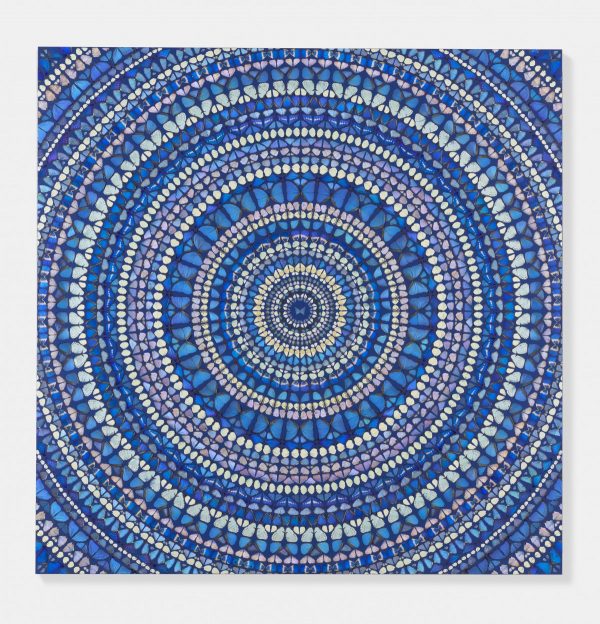
Martyr, Damien Hirst, 2019. Image White Cube
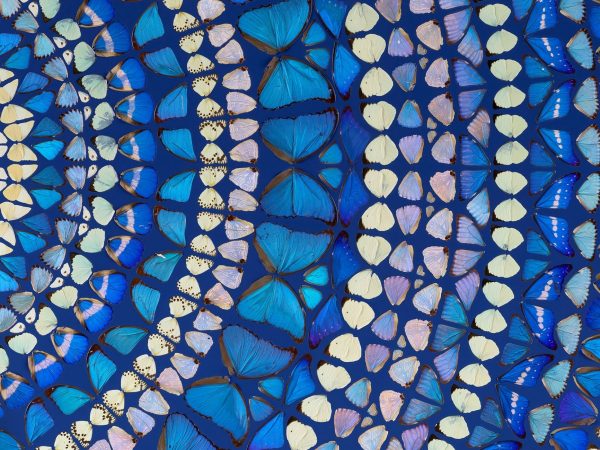
Detail, Martyr, Damian Hirst, 2019. Image White Cube
The form of the mandala is heavily present in the natural world. Next time you are looking at a flower, fruit, or even your own eye you may spot a mandala-like design! From top left, a flower, inside of a kiwi, inside of a tree trunk and another flower.
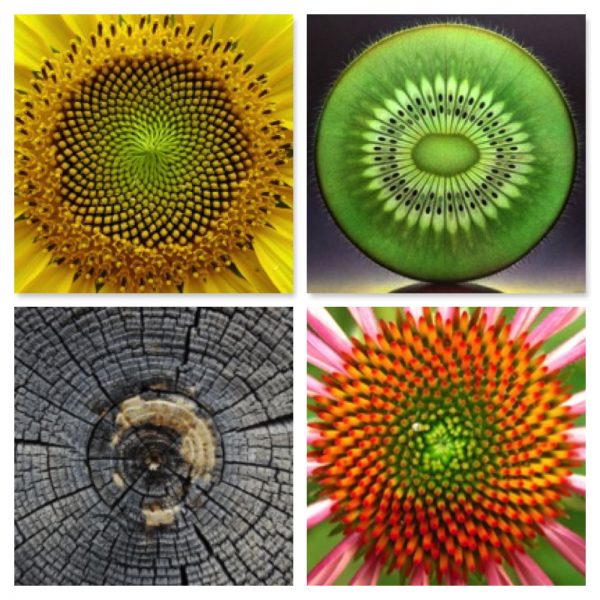
“Learn how to see. Realize that everything connects to everything else.” Leonardo Da Vinci